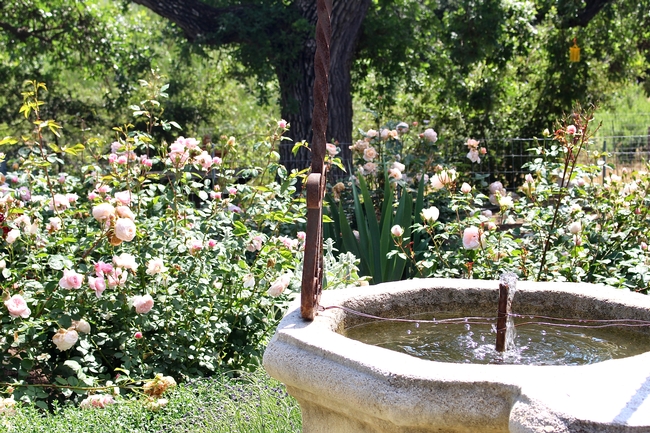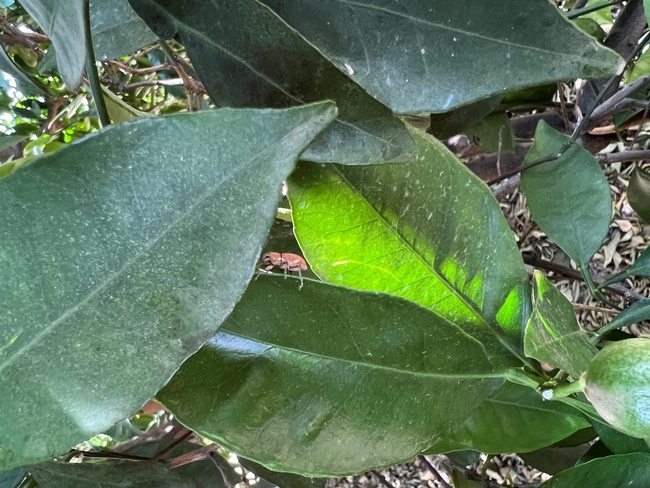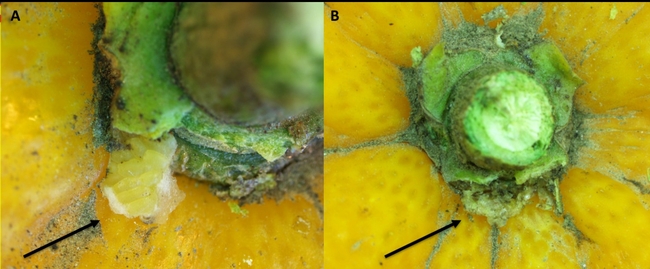Posts Tagged: rose
Lawn-pocalypse! Surviving Drought
Ah, summer! The season of sunburns, pool parties, and… lawn droughts. If your once lush, green carpet now looks like a crunchy brown doormat, you're not alone. Let's dive into why your yard is staging a dramatic death scene and what you can do to...

Bermuda grass and weeds overtaking drought stressed turf grass.
Pruning Roses and Cultivating Beauty
Pruning roses is not just a chore; it's an important practice for nurturing vibrant, healthy roses and fostering the beauty of your garden. In California, where the climate is favorable for growing roses, understanding the significance of pruning is key to achieving thriving and healthy roses.
Why Prune?
Pruning isn't merely about maintaining a tidy appearance; it's about promoting the overall well-being of your roses:
- Annual pruning stimulates plant and shoot growth, leading to larger blooms and a more robust structure.
- Removing dead, damaged, or diseased canes minimizes the risk of fungal infections and pest infestations, fostering plant health.
- Thinning out dense growth improves air circulation within the plant, reducing the likelihood of fungal diseases like powdery mildew and black spot.
- Shaping the plant through pruning enhances its visual appeal, creating a more attractive landscape.
When to Prune
Timing is important when it comes to pruning roses. In California, where winters are mild, the ideal time for pruning is typically between late winter and early spring. Pruning during dormancy allows the plant to focus its energy on new growth when spring arrives.
How to Prune
Pruning may seem daunting, but with the right approach, it becomes a manageable task:
- If the plant is dormant (recommended), remove all remaining leaves.
- Use sharp, clean pruning shears and loppers to make precise cuts, minimizing damage to the plant.
- Trim back old growth by about one-third to improve visibility and encourage new growth. Remove dead, diseased, or crossing canes to maintain a healthy structure.
- Make pruning cuts approximately ¼-1/2” above an outward-facing bud. Pruning cuts should be at a 45-degree angle, sloping away from the outward-facing bud.
- Create an open, vase-like shape by removing canes from the center of the plant. This promotes airflow and sunlight penetration, which is essential for plant health.
- Clear away debris and old leaves to prevent disease spread. Consider applying insecticidal soap or horticultural oil during dormancy to control pests.
Conclusion
Pruning roses is a fundamental aspect of rose care that should not be overlooked. By understanding the importance of pruning and following basic pruning principles, you can nurture thriving roses that add beauty and vitality to your garden year after year. For more details on growing roses and pruning timelines for your area contact your local UC Master Gardener Program.
Bruce Hammock Inducted as Fellow of the California Academy of Sciences
UC Davis distinguished professor Bruce Hammock, internationally recognized for discovering a new group of human chemical mediators, is a newly inducted Fellow of the California Academy of Sciences (CAS). Hammock, who holds a joint appointment...

UC Davis distinguished professor Bruce Hammock in his office in Briggs Hall. (Photo by Kathy Keatley Garvey)

The California Academy of Sciences building. (2008 Copyrighted Photo by Tim Griffith, California Academy of Sciences)
Fuller Rose Beetle Sampling Protocol
USDA-APHIS Approves New Fuller Rose Beetle Mitigation – a Voluntary Option to Reduce Pesticide Applications
By
Sandipa Gautam, Area Citrus IPM Advisor UCCE
James R Cranney, President CCQC
At the request of the California Citrus Quality Council (CCQC) USDA's Animal and Plant Health Inspection Service (APHIS) has approved a new sampling protocol that growers can use to reduce pesticide applications for control of Fuller rose beetle (FRB), a quarantine pest in South Korea.
Fuller rose beetles are brown, flightless, snout beetles that have one generation in a year (Figure 1). Three-fourths of their life cycle is spent under the ground where they feed on roots and go through development. Adults emerge from the ground year-round, but the major emergence in the San Joaquin Valley occurs July-September, with 53% of beetles emerging in August. All beetles are females and adult females do not require mating to begin reproduction. Beetles climb to the tree canopy and feed on citrus leaves and lay eggs on cracks and crevices including the under the sepal (Figure 2). Eggs can be present at the time of harvest, thereby making this beetle a quarantine concern for Korea's Animal and Plant Quarantine Agency.
Figure. 1. Fuller rose beetle adult (right there, centered in the triangle).
Figure 2. Fuller rose beetle egg masses, live eggs (A) – note yellowish and plump eggs; dead or hatched eggs (B) – dried out egg mass.
Current Practices for FRB Management
Growers have been using a system's approach which combines cultural and chemical methods to target FRB, since 2010. The goal of FRB management is to reduce the beetle population and egg laying. Current regulatory requirements for managing FRB are
a) Skirt Pruning sufficient to prevent tree skirts from contacting the ground
b) Weed control sufficient to prevent forming a bridge from ground to tree skirt
c) Two insecticide treatments to control Fuller rose beetle using only University of California recommended pesticides from the UCANR IPM Guidelines web page at http://ipm.ucanr.edu/PMG/r107300311.html
In recent years, most growers and pest control advisors have reported that they no longer detect beetles in most citrus groves. Furthermore, the USDA APHIS interception rate from phytosanitary inspections, where 600 fruits per container are sampled for FRB egg masses, FRB was found in only 0.05 percent of all containers. This indicates that FRB populations are very low in citrus groves.
Since FRB populations in citrus groves are historically low, CCQC has proposed an additional voluntary option for the Korea FRB Protocol to reduce pesticide use:
- Trees must be skirt pruned to minimize branches touching the ground.
- Herbicide treatments should be made to eliminate weeds that could be a pathway into the tree.
- Either option a or option b
a) Growers must make two pesticide applications to control FRB using pesticides recommended on the University of California Citrus IPM website https://ipm.ucanr.edu/agriculture/citrus/fuller-rose-beetle/
b) Growers must use the FRB sampling protocol (below), keep records and if no more than two FRB-infested trees per sample are detected they may eliminate the first application and make one application, preferably before October 31 with pesticides recommended on the citrus IPM website.
Fuller Rose Beetle Sampling Protocol:
- Growers should conduct Fuller rose beetle (FRB) sampling from Aug. 7 – Aug. 31 since that is the peak period of emergence.
- Conduct a random sample in each citrus block.
- Divide the block into four quadrants and sample 18 trees that are spread equally apart in each quadrant. A total number of trees sampled is 72 trees.
- Growers or Pest Control Advisors (PCA) should:
i. Check suckers inside the tree for signs of FRB leaf chewing and if beetles are detected the tree is considered infested.
ii. If no beetles are found in the interior, shake two large outside branches over a light cloth and inspect for FRB. If beetles are found, the tree is considered infested.
- Growers must keep records on the results of the sampling including (i) block identification, (ii) inspection date, (iii) name of inspector, and (iv) number of trees infested with beetles out of 72 trees inspected.
- If no more than two infested trees are found, growers may eliminate the first FRB pesticide application. If two infested trees are found, growers must make a pesticide application in August or early September.
- If no more than two infested trees are found, growers are still required to make one pesticide application to control FRB, preferably before October 31.
How will the new protocol help?
- Reduced pesticide use could reduce grower costs to manage FRB.
- Fewer pesticide applications should improve biological control in citrus groves by preserving beneficial insects. Many PCAs and growers attribute severe mealy bug outbreaks to increased pesticide use to control FRB and Asian citrus psyllid.
- Reducing pesticide use to control FRB will help California citrus growers adopt more sustainable production practices and align the industry with the California Department of Pesticide Regulation's Sustainable Pest Management Roadmap.
References:
UCIPM 2017. Citrus Pest Management Guidelines: Fuller Rose Beetle. https://ipm.ucanr.edu/agriculture/citrus/fuller-rose-beetle/
Climate-Change Resources
University of California UC ANR Green Blog (Climate Change and Other Topics) https://ucanr.edu/blogs/Green/index.cfm?tagname=climate%20change (full index)
Examples:
- Save Trees First: Tips to Keep Them Alive Under Drought https://ucanr.edu/b/~CdD
- Landscaping with Fire Exposure in Mind: https://ucanr.edu/b/~G4D
- Cities in California Inland Areas Must Make Street Tree Changes to adapt to Future Climate https://ucanr.edu/b/~oF7
Drought, Climate Change and California Water Management Ted Grantham, UC Cooperative Extension specialist (23 minutes) https://youtu.be/dlimj75Wn9Q
Climate Variability and Change: Trends and Impacts on CA Agriculture Tapan Pathak, UC Cooperative Extension specialist (24 minutes) https://youtu.be/bIHI0yqqQJc
California Institute for Water Resources (links to blogs, talks, podcasts, water experts, etc.) https://ciwr.ucanr.edu/California_Drought_Expertise/
UC ANR Wildfire Resources (publications, videos, etc.) https://ucanr.edu/News/For_the_media/Press_kits/Wildfire/ (main website)
-UC ANR Fire Resources and Information https://ucanr.edu/sites/fire/ (main website)
-Preparing Home Landscaping https://ucanr.edu/sites/fire/Prepare/Landscaping/
UC ANR Free Publications https://anrcatalog.ucanr.edu/ (main website)
- Benefits of Plants to Humans and Urban Ecosystems: https://anrcatalog.ucanr.edu/pdf/8726.pdf
-Keeping Plants Alive Under Drought and Water Restrictions (English version) https://anrcatalog.ucanr.edu/pdf/8553.pdf
(Spanish version) https://anrcatalog.ucanr.edu/pdf/8628.pdf
- Use of Graywater in Urban Landscapes https://anrcatalog.ucanr.edu/pdf/8536.pdf
- Sustainable Landscaping in California https://anrcatalog.ucanr.edu/pdf/8504.pdf
Other (Non-UC) Climate Change Resources
Urban Forests and Climate Change. Urban forests play an important role in climate change mitigation and adaptation. Active stewardship of a community's forestry assets can strengthen local resilience to climate change while creating more sustainable and desirable places to live. https://www.fs.usda.gov/ccrc/topics/urban-forests
Examining the Viability of Planting Trees to Mitigate Climate Change (plausible at the forest level) https://climate.nasa.gov/news/2927/examining-the-viability-of-planting-trees-to-help-mitigate-climate-change/
Reports and other information resources coordinated under the auspices of the United Nations and produced through the collaboration of thousands of international scientists to provide a clear and up to date view of the current state of scientific knowledge relevant to climate change. United Nations Climate Action
Scientific reports, programs, action movements and events related to climate change. National Center for Atmospheric Research (National Science Foundation)
Find useful reports, program information and other documents resulting from federally funded research and development into the behavior of the atmosphere and related physical, biological and social systems. Search and find climate data from prehistory through to an hour ago in the world's largest climate data archive. (Formerly the "Climatic Data Center") National Centers for Environmental Information (NOAA)
Think tank providing information, analysis, policy and solution development for addressing climate change and energy issues (formerly known as the: "Pew Center on Global Climate Change"). Center for Climate & Energy Solutions (C2ES)
Mapping Resilience: A Blueprint for Thriving in the Face of Climate Disaster. The Climate Adaptation Knowledge Exchange (CAKE) was launched in July 2010 and is managed by EcoAdapt, a non-profit with a singular mission: to create a robust future in the face of climate change by bringing together diverse players to reshape planning and management in response to rapid climate change. https://www.cakex.org/documents/mapping-resilience-blueprint-thriving-face-climate-disaster
Cal-Adapt provides a way to explore peer-reviewed data that portrays how climate change might affect California at the state and local level. We make this data available through downloads, visualizations, and the Cal-Adapt API for your research, outreach, and adaptation planning needs. Cal-Adapt is a collaboration between state agency funding programs, university and private sector researchers https://cal-adapt.org/
Find reports, maps, data and other resources produced through a confederation of the research arms of 13 Federal departments and agencies that carry out research and develop and maintain capabilities that support the Nation's response to global change. Global Change (U.S. Global Change Research Program)
The Pacific Institute is a global water think tank that combines science-based thought leadership with active outreach to influence local, national, and international efforts to develop sustainable water policies. https://pacinst.org/our-approach/
Making equity real in climate adaptation and community resilience policies and programs: a guidebook. https://greenlining.org/publications/2019/making-equity-real-in-climate-adaption-and-community-resilience-policies-and-programs-a-guidebook/
Quarterly CA Climate Updates and CA Drought Monitor Maps (updated each Thursday) https://www.drought.gov/documents/quarterly-climate-impacts-and-outlook-western-region-june-2022




